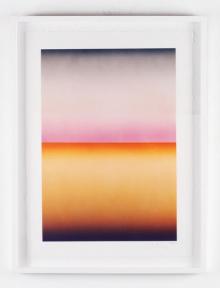2020 brought a wave of unexpected circumstances, yet I have never been more certain that artists, no matter, will prevail through all extremes. With days on end of confinement, the visual culture immediately got to work with virtual exhibitions, online art fairs, zoomed studio visits, live Instagram programing, and numerous auctions for charity. An affirmation of visual culture’s ability to rise above all circumstances and stay ahead of the current, impacting those who view it in ways only art can do.
With an effort to keep up the positive momentum, our featured artists have created small paintings, replete with visual impact and a perfect way to add a piece to your collection. From luminous paintings filled with perceptual wonder to energetic brush work that acts as a conduit of pure emotion, each piece shown provides a threshold of experience, opening the doors to insight and initiating wonder.
I look forward to sharing the work of artists who have changed the way I see. My hope is that through my words, you will see the adoration I have for the work and feel the same excitement. I want you to trust the act of perception that art initiates and take the time to process it. Most of all, I want you to discover the fascinating and extraordinary personal shift that art provides to those who take the time to witness it.
"There's a place beyond words where experience first occurs to which I always want to return."
Jerzy Kosinski, The Painted Bird

Jimi GLeason
“By using an iridescent surface coat, I have managed to create visual spaces that respond to both the play of light and the location of the viewer”.
Jimi Gleason, Voyage LA





Henry Jackson
“… the uncertainty that Jackson’s paintings arouse as to whether they seek the figure as a core, or seek to disavow it. That ambiguity reads as their true preoccupation. All this might seem anachronistic but for Jackson’s prodigious skill as a colorist. Any number of individual hues in Jackson's work can make a distasteful impression under too close a focus. But relax your gaze enough to see their interaction and it quickly comes to seem the paintings' true pretext and substance.”
Kenneth Baker, SF Chronicle


Robert Minervini
“The word “Utopia” originates from the literal Greek meaning “not place,” suggesting that perfection can only exist in the realm of imagination. My work presents invented spaces that are based on reality, but revel in artificiality. In these desolate dreamlike non-places, I subvert nature and construct or destroy architectural sites alluding to the making of a utopian and/or dystopian environment."
Robert Minervini


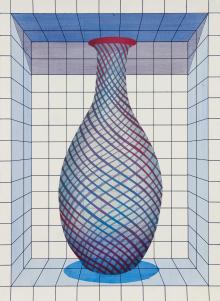

Robert Minervini, Hand Embellished Print "Between Artifice and Authenticity Comes Reality"
Acrylic on Unique Archival Digital Print, 30” round image,
35” x 35” paper, 2020 signed

Patti oleon
“Working with my photographs, I create a composite image that becomes the ultimate blueprint for my paintings by digitally layering alternative views of the same space. Differing in color, hue, transparency, each new stratum retains its integrity while subtly altering the appearance of the whole and adding additional nuance. The phenomenon of layering and often mirroring is of interest to me because it introduces the suggestion of a temporal element, and confounds the viewer in his/her perception of what is real. The final paintings are an amalgam of contradictions, blurring the line between the real and the artificial, the dark and the light, and the banal and the transcendent. “
Patti Oleon



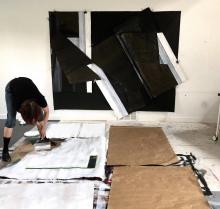
Kate Petley
“Transformation lies at the heart of my work, for the materials and as content. I deliberately emphasize positivity to contrast these unsettling times. I’m interested in how abstraction might contain and literally illuminate the senses, particularly when distraction rules…to make manifest some of what we cannot see.”
Kate Petley


Eric Sall
“I find inspiration in nature, in things such as changing light, saturated color, the power of weather, and the open landscape. Having spent considerable time living in more rural areas of the American Midwest, central plains, and southwest, I have made a deep connection to the land, and it's environment. Yet I have lived in large cities as well, and experiencing the random juxtaposition of the urban environment has also been influential. I can appreciate the world of design and decoration found in things like patterned clothes, company logos, and contemporary architecture, as well as the banality of old warehouse walls, empty parking lots and stray advertisements.”
Eric Sall




Lorraine Tady
“For me, “painting" has always been about process and this wrestle between painting and drawing (and sculpture/building); and my process has a sort of printmaker’s approach (variation, reusing images, alterations) and it involves a slow building of the image. For me re-accessing my images in various ways throughout my career concerned my interest in image structure. The mechanical or digital in painting is yet another tool for me to use in my investigative process.”
Lorraine Tady




Liz TRosper
“The work plays off the meme titled Dandelion vs. Rose, which first originated about 6 years ago. ‘What interested me about this meme was the fine point it put on human intervention in cultivation and breeding, its powerful influence and unintended consequences. As a weed, a plant that is not valued where it is growing and is growing vigorously, dandelion comes from dent de lion, French for the lion’s tooth. This cycle of works -- Dandelion and Rose and Radiant Love -- explores themes of brightness, kindness and resilience. These works are scanner paintings made with a combination of material and digital painting processes.'
Liz Trosper





Chris Trueman
“I’ve started calling them de-materialized paintings. I’m thinking a lot about the digital world we live in and how most images we see are mediated through screens. Often, we believe we have seen an event or an object because we have seen images or posts of the object, but those impressions are removed from context and without scale, even if you can get a sense for the scale, you can’t truly get a sense of what you are looking at and, in this scenario,, it would only be the one sense that describes the experience. What does it mean to make paintings and objects in a world where they will inevitably be seen without the original physicality? I’m using the paintings to talk about how many experiences are changing.”
Chris Trueman, Voyage LA
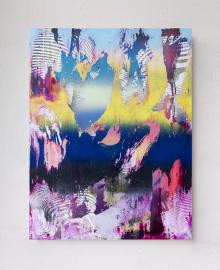


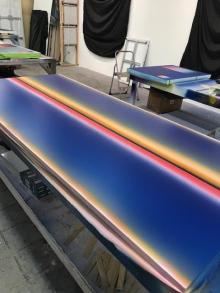
Casper Brindle
“Primarily, I make large-scale, abstract, atmospheric color-field paintings. I have spent most of my free time in the ocean, staring into that infinite horizon where the sky meets water, which has deeply affected my work. I’m fascinated by the endless shifting of colors in the natural world. When I’m making paintings, I’m interested in engaging the viewer and playing with their perception, trying to harness that ephemeral quality of light changing over time. It activates that same part of your brain that opens up when you take a long drive when you’re so deep in your subconscious that you don’t quite remember how you got there, but somehow you’ve arrived."
Casper Brindle

